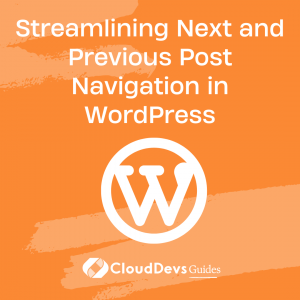Streamlining Next and Previous Post Navigation in WordPress
Table of Contents
Navigating through a WordPress blog often involves the use of next and previous post links at the end of each article. However, when there is no next or previous post available, the corresponding text may appear without a link, creating a less polished user experience. In this article, we will discuss how to ensure proper display of next and previous post links and provide tips to enhance your blog’s overall appearance and functionality.
1. Checking for the Existence of Next and Previous Posts
To prevent the “Next post” and “Previous post” text from appearing without a link, you can use the following code snippets:
For the next post:
<?php if (strlen(get_next_post()->post_title) > 0) { ?>
Next Post: <?php next_post_link( '%link', '%title »' ) ?>
<?php } ?>
For the previous post:
<?php if (strlen(get_previous_post()->post_title) > 0) { ?>
Previous Post: <?php previous_post_link( '%link', '%title »' ) ?>
<?php } ?>
These code snippets check if the length of the post title of the next or previous post is greater than zero, and if so, display the respective link.
2. Tips for Enhancing Your Blog’s User Experience
In addition to managing next and previous post links, consider the following tips to further improve your blog’s user experience:
2.1 Selecting a Responsive and Attractive Theme
Choose a mobile-friendly and visually appealing theme that suits your specific needs and preferences.
2.2 Ensuring Fast Loading Times
Optimize your images, use a caching plugin, and invest in reliable hosting to improve your site’s speed and keep readers engaged.
2.3 Updating Your Blog Regularly
Consistently adding fresh content signals to search engines that your blog is active and relevant, which can drive more traffic to your site.
2.4 Encouraging Reader Engagement
Make it easy for readers to comment, share, and subscribe to your blog to foster a sense of community and increase the likelihood they will return.
2.5 Optimizing for SEO
Utilize relevant keywords, meta descriptions, and proper headings to help search engines understand and index your content effectively, improving your blog’s visibility and traffic.
3. Conclusion
By implementing the code snippets for displaying next and previous post links and following the tips outlined above, you can create a more user-friendly and visually appealing WordPress blog. These small details can significantly impact your blog’s overall appearance and functionality, contributing to a better experience for your readers. Happy blogging!


